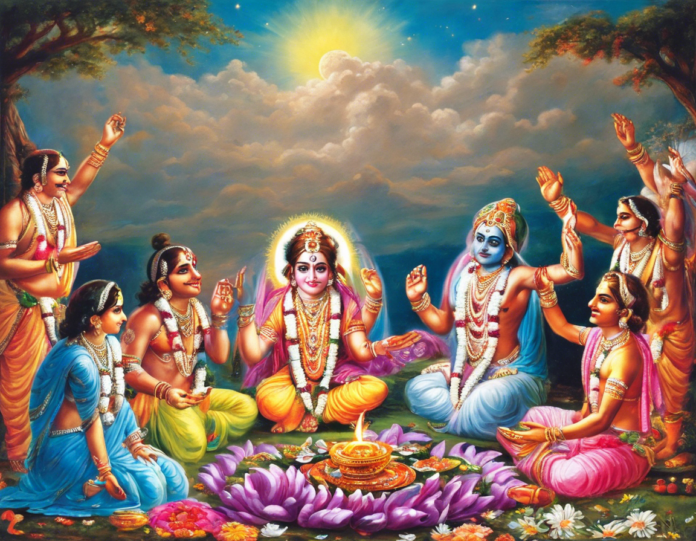Introduction
In the rich tapestry of Hindu culture, Ekadashi Vrat holds a revered place as one of the most important fasts observed by devotees. The term “Ekadashi” originates from Sanskrit, where “Ek” means one and “Dashi” means ten, signifying the eleventh day in the Hindu lunar calendar. The significance of observing Ekadashi Vrat is not just rooted in tradition but also holds spiritual and health benefits.
The Story Behind Ekadashi Vrat
One of the most popular legends associated with Ekadashi Vrat is the narrative of King Yudhishthira from the epic Mahabharata. It is said that Yudhishthira approached Lord Krishna seeking a solution to his problems. In response, Lord Krishna narrated the significance of observing Ekadashi Vrat and how it had the power to alleviate all of his issues. Impressed by the words of Lord Krishna, Yudhishthira diligently observed Ekadashi Vrat and eventually overcame all his obstacles.
Spiritual Significance of Ekadashi Vrat
Ekadashi Vrat is not merely a physical act of abstaining from food but also a spiritual endeavor aimed at purifying the mind and body. It is believed that observing Ekadashi Vrat helps in atoning for past sins, invoking divine blessings, and enhancing spiritual growth. The practice of fasting on Ekadashi is considered auspicious and is believed to please Lord Vishnu, the preserver of the universe.
Health Benefits of Ekadashi Vrat
Apart from its spiritual connotations, Ekadashi Vrat also offers various health benefits. Fasting on this day allows the digestive system to rest, detoxifies the body, and aids in weight management. The consumption of light and sattvic foods during Ekadashi helps in maintaining overall well-being and promotes a healthier lifestyle.
Rituals Associated with Ekadashi Vrat
The observance of Ekadashi Vrat goes beyond fasting and encompasses various rituals that are to be followed devoutly. Devotees wake up early, take a ritual bath, and spend the day in prayer and meditation. It is customary to visit temples, offer prayers to Lord Vishnu, and engage in charitable acts. The fast is broken on the next day, Dwadashi, after performing the necessary rituals.
Types of Ekadashi Vrat
There are two types of Ekadashi Vrat that are widely observed by devotees – Nirjala Ekadashi and Sankashti Chaturthi. Nirjala Ekadashi is considered the most stringent form of fasting where devotees abstain from food and water throughout the day and night. Sankashti Chaturthi, on the other hand, involves fasting from sunrise to moonrise and is dedicated to Lord Ganesha.
Significance of Foods Consumed on Ekadashi
During Ekadashi, it is customary to consume sattvic foods that are light on the stomach and easy to digest. Some of the commonly consumed foods include fruits, nuts, milk, sabudana, and specific vegetables. Avoiding grains and non-vegetarian food is a common practice during Ekadashi Vrat.
Tips for Observing Ekadashi Vrat
For individuals looking to observe Ekadashi Vrat, here are some helpful tips to enhance the spiritual experience:
- Start the day early with meditation and prayers.
- Maintain a pure and positive mindset throughout the day.
- Engage in acts of charity and kindness.
- Avoid engaging in negative thoughts or activities.
- Consume light and sattvic foods during the fast.
- Break the fast with moderation and gratitude.
Frequently Asked Questions (FAQs)
- Can anyone observe Ekadashi Vrat?
-
Yes, Ekadashi Vrat can be observed by individuals of all ages who are willing to fast and follow the prescribed rituals.
-
Is it necessary to fast without water on Nirjala Ekadashi?
-
While fasting without water is recommended on Nirjala Ekadashi, individuals who find it challenging can consume water but refrain from food.
-
What if one is unable to observe Ekadashi due to health reasons?
-
Those who are unwell or are medically advised against fasting can donate food or perform other acts of charity as an alternative way of observing Ekadashi.
-
Can pregnant women or young children observe Ekadashi Vrat?
-
Pregnant women and young children are exempt from fasting during Ekadashi. They can participate in prayers and rituals without fasting.
-
How does observing Ekadashi Vrat benefit one spiritually?
-
Observing Ekadashi Vrat helps in purifying the mind, body, and soul, promoting spiritual growth, and seeking the blessings of the divine.
-
What foods are recommended during Ekadashi Vrat?
- Fruits, nuts, milk, sabudana, specific vegetables, and sattvic foods are commonly consumed during Ekadashi Vrat.
In conclusion, Ekadashi Vrat stands as a powerful practice that not only strengthens one’s faith but also nurtures physical and mental well-being. By observing this sacred fast with devotion and sincerity, individuals can embark on a transformative journey towards spiritual growth and inner harmony.












